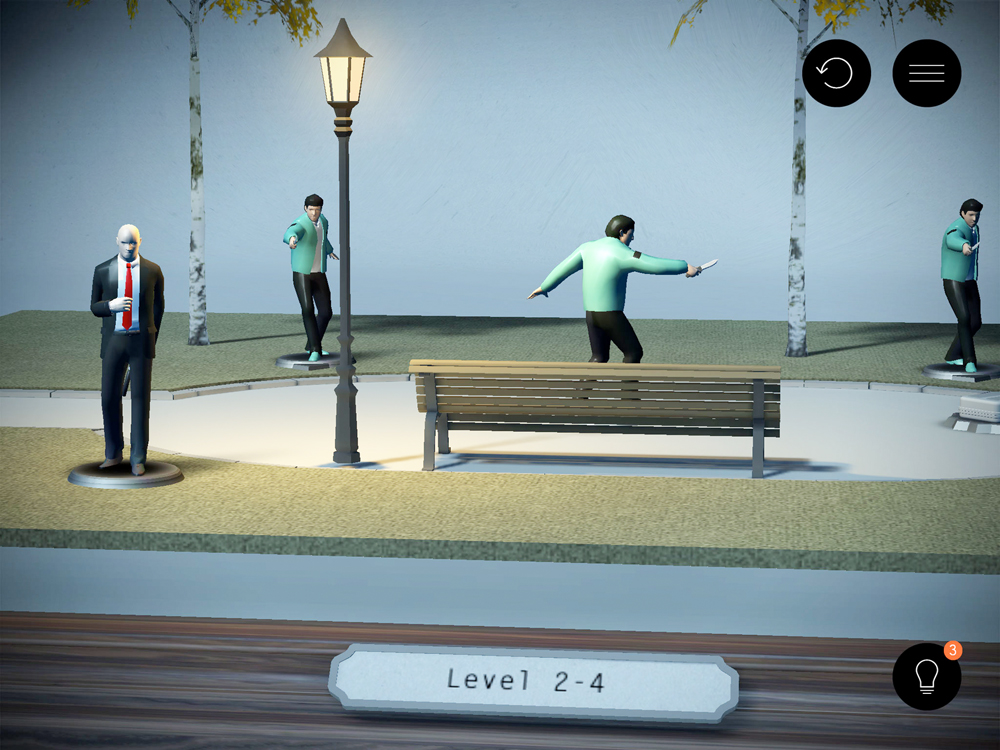Like a good assassin, Hitman Go seems to have come out of nowhere. After the somewhat middling Hitman: Absolution (2012), it was reasonable to assume that the once venerated series might hang up its piano wire for a while, a sort of forced retirement, until the dust settled and the world was ready for another Hitman game. The last thing anyone expected was for the series to make a quick comeback as a digital board game and, additionally, for said game to be really, really good. Yet here we are.
Conceptually, Hitman Go isn’t too different from the rest of the series. You reprise the role of the iconic bald assassin, Agent 47, who immediately gets down to doing what he does best: murderin’ fools. That’s where the similarities end, though. Hitman Go eschews the gameplay style of its predecessors by stripping away the expansive environments that defined the series at its height. Hitman Go is a tight, focused little game.
The first thing you’ll notice about the game is its aesthetic, which combines board game layout with sleek ’60s design. All characters are represented as static figurines that move along designated pathways. Swipe the touchscreen and Agent 47 moves appropriately. The levels themselves are smart, minimalistic boards, each with their own unifying theme. The board game aesthetic even extends to the stage select screen, where stages are represented by cardboard game boxes.
Hitman Go is stunning to look at, though there were rare instances where a clumsily placed camera angle made it difficult to see an approaching enemy which resulted in my death. To the game’s credit, the board resets quickly upon failure. Regardless, the odd camera angle snafus tended to happen more often on larger boards, and it was a bummer to lose that much progress in an instant.
The main goal of each level is to reach the exit or, on certain occasions, assassinate a target. While you spend much of your time avoiding enemies, you can remove them from the board if you take them unawares and slide onto the space they occupy. Even here the board game aesthetic is retained; enemies don’t disappear when they’re removed from the board. Instead their figurine appears overturned just off the board as would a vanquished piece in chess. It’s a small but clever detail.
Every level includes two additional goals, both of which require you to reach the exit while abiding by specific limitations. These limitations include things like conducting a no-kill run, grabbing a briefcase (which is often placed at a particularly hairy location on the map), and completing the level in, or under, a specific number of moves.
Some of these additional objectives are no-brainers, but most made me rethink the layout of levels. More than once I found myself finishing a level I had already completed via a wildly different route. My one gripe was with the par missions. The game lacks a counter to keep track of how many moves you’ve made. On levels where the par hovered around thirty, I often found myself wishing for some help in keeping count.
Hitman Go never feels stale despite its simple conceptual roots. Agent 47 is in a constant arms race with his enemies. You’re constantly given new and inventive ways of removing your adversaries from the boards, including costumes and weapons. Your enemies, in turn, start adopting new defenses and patrol patterns, among other things. The result is a game that requires constant experimentation because the tactic you used in the last level almost certainly won’t work on the next.
While Hitman Go does include in-app purchases, they’re some of the least intrusive I’ve ever come across. At the start of the game you are allotted five hints which, when activated, walk you through one of a level’s three objectives. So they’re less “hints” and more “answers.” When you’ve used all five of your hints you can purchase more from the store interface. I found the hints to be largely superfluous, as are most of the objectives in the game. While they are not overly easy, they can be worked through given enough time and concentration. If you find yourself needing guidance, though, you’ll have to pay up: There’s no other way to refill hints over the course of the game.
I never got deep into the console Hitman games. I found them cumbersome and demanding. In this way, Hitman Go is something of an epiphany. It translates the core concepts of the Hitman series to a mobile platform while managing to put a new spin on the whole thing. It’s remarkably slick and, once it’s got you in its sights, it’s hard to get away.





